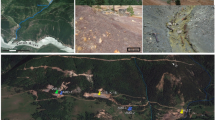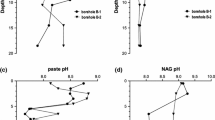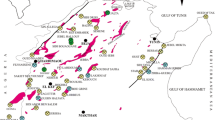Abstract
This study investigates the retention of heavy metals in secondary precipitates from a sulfidic mine rock dump and underlying podzolic soils by means of mineralogical and chemical extraction methods. The rock dump, which is at least 50 years old, consists of a 5–10-cm-thick leached zone and an underlying 110–115-cm-thick accumulation zone. Optical microscopy and electron microprobe analyses confirm that pyrrhotite weathering has proceeded much further in the leached horizon relative to the accumulation horizon. The weathering of sulfides in the leached zone has resulted in the migration of most heavy metals to the accumulation zone or underlying soils, where they are retained in more stable phases such as secondary ferric minerals, including goethite and jarosite. Some metals are temporarily retained in hydrated ferrous sulfates (e.g., melanterite, rozenite).
Similar content being viewed by others
Author information
Authors and Affiliations
Additional information
Received: 28 October 1996 · Accepted: 24 February 1997
Rights and permissions
About this article
Cite this article
Lin, Z., Herbert Jr., R. Heavy metal retention in secondary precipitates from a mine rock dump and underlying soil, Dalarna, Sweden. Environmental Geology 33, 1–12 (1997). https://doi.org/10.1007/s002540050220
Issue Date:
DOI: https://doi.org/10.1007/s002540050220




